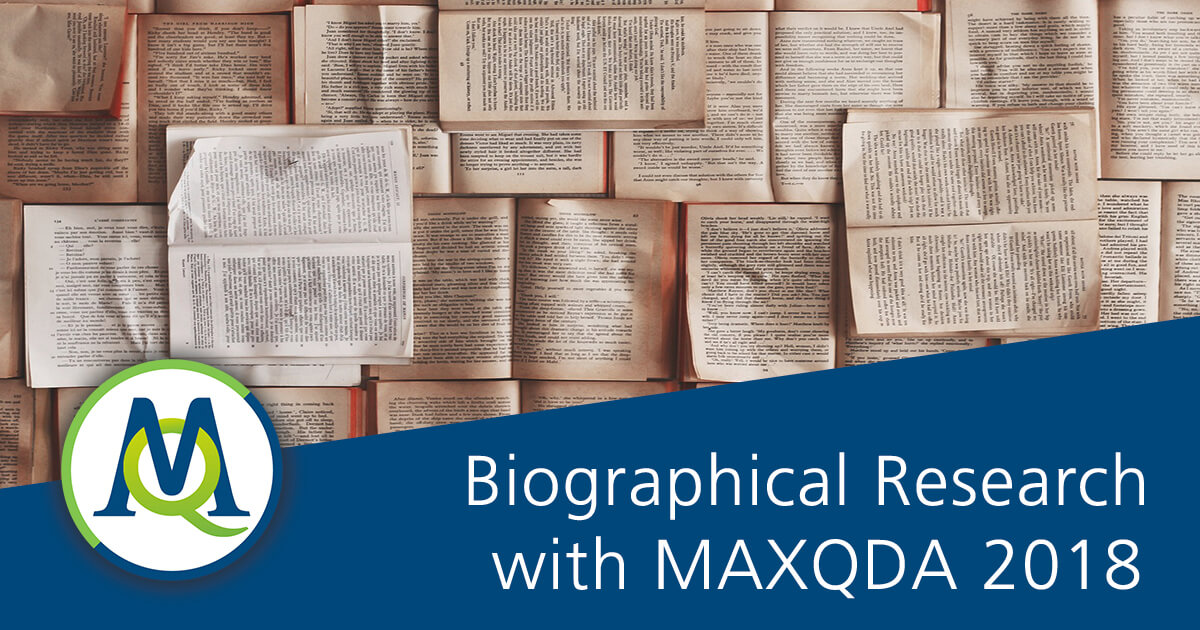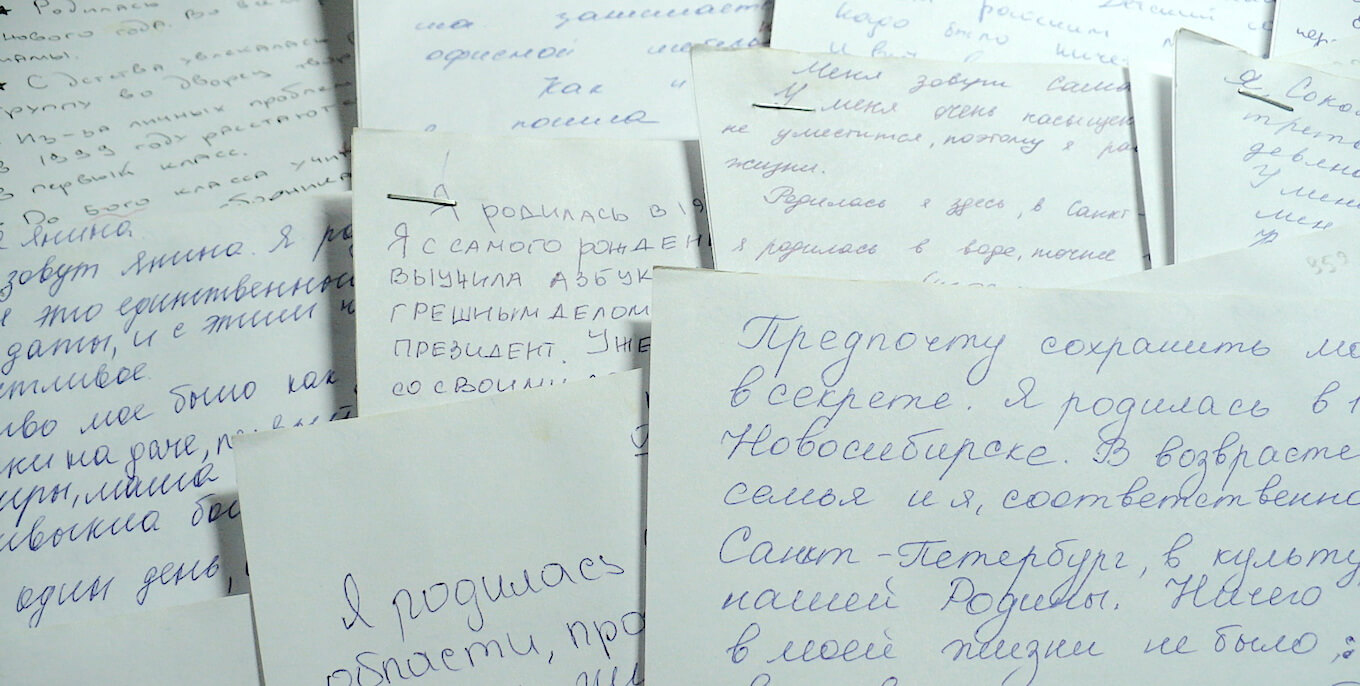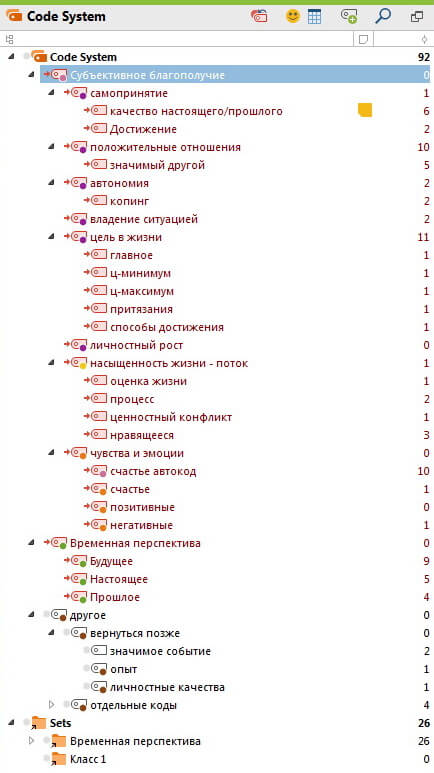Guest Post by Konstantin Divisenko.

Youth Lifeworlds
My academic interests are related to studies of “youth lifeworlds” (specifically high school students) according to their qualitative data, i.e. biographical texts.
In the early stages of my research, I did not use any software tools. I soon realized, however, that analyzing large numbers of lengthy texts (from scratch) is quite a complicated process: it requires a lot of paper and code lists, plus you have to keep an enormous amount of information in your mind at all times. It’s also very hard to change your coding framework if / when needed.
My most recent research is aimed at studying the subjective wellbeing of young people using biographical data – autobiographies and biographical essays. The data was collected in 2010 and 2018. The autobiographies were written by high school students (grades 9 – 11) in St. Petersburg.
The lifeworld approach and models of wellbeing
I’ve been using the theoretical and methodological framework of the lifeworld approach, qualitative analysis of subjective wellbeing by Graciela Tonon, and the multidimensional model of wellbeing by Carol Ryff. Generally, this type of research is aimed at defining various types of subjective wellbeing in their relation to young people’s projects in life.
The benefit of using biographical narratives to analyze how a person perceives their own life is based on the idea that thematization of the phenomenon of consciousness occurs indirectly and in a broader context, rather than when that person is directly asked about experiencing own wellbeing, satisfaction with various spheres of life, or the feeling of happiness.
Avoiding direct questions
This strategy is primarily linked to the notion that direct questions themselves define a certain context within the representation of perspectives on subjectively significant values. It is problematic to use them because direct questions investigate not the phenomenon itself, but the person’s individually, socially, and culturally conditioned reaction.
Furthermore, a study of subjective values via the investigation of a person’s biographical materials allows you to describe and comprehend the true significance of objective indicators of the quality of life of social groups or individuals.

School student manuscripts (autobiographies and biographical essays)
Analyses with MAXQDA
When autobiographies and biographical essays “This is me N years from now …” were written by hand, I didn’t use MAXQDA’s Transcription Mode, even though MAXQDA 2018 provides all tools necessary for conducting every stage of qualitative research – from field study and primary data analysis to writing a study report. Its vast range of built-in functionalities (including its coding system, visual tools, content analysis functions etc.) will cover all your qualitative analysis needs. I’ll now describe some of the functions I used in detail.
“MAXQDA 2018 can greatly lighten a researcher’s workload when analyzing qualitative data.”Konstantin Divisenko
Coding with MAXQDA

My core analysis work involved coding the data. The multidimensional approach to understanding subjective wellbeing presupposes an initial code system that relates to particular wellbeing domains: positive self-evaluation, presence of trust-based relations, coping, skills of overcoming hardships while accomplishing tasks and goals, meaning of life, process of self-development, etc.
However, each aspect of wellbeing required clarification on how it was represented in the text. While coding, it quickly became clear that some fragments can’t be assigned to a single domain. Hence, new codes had to be developed. MAXQDA’s “Code System” window allowed me to easily develop several hierarchies of codes and assign different colors to them.
My code system (in Russian) was divided into three categories: “Subjective Wellbeing”, “Time Perspective”, and “Other”, as shown in this first screenshot (right).
Memos
MAXQDA’s Memo function was another important tool for my research analysis process. Creating memos allowed me to make notes on the contents of categories and then use the texts of these notes in the future article’s methodological outline. I assigned memos both to codes and to various parts of the texts.
I assigned MAXQDA’s “?” memo symbol to those fragments which couldn’t be referred to a specific wellbeing element; the “M” memo symbol stood for methodological comments; for instance, whether it’s appropriate or not to see other individuals mentioned in biographies as an indirect proof for the presence of positive social interactions.
Re-coding made easy with MAXQDA’s retrieval tool
I then reanalyzed the results of my open coding round in MAXQDA’s “Retrieved Segments” window: here I could unite my codes under bigger groups and associate them with basic wellbeing domains. It turned out that some of them could be placed directly into my preliminary code system; however, some of the other codes had to be united into two separate groups, namely “The Intension of Life” and “Feelings/Emotions”.
Thanks to the coding tools available in the “Retrieved Segments” window, you don’t need to worry about making the error of creating two similar codes, since it’s quite easy to unite or clarify them later.
Code Relations Browser
Moreover, MAXQDA’s Code Relations Browser was used to visually present the interconnections between different codes. A lack of links (of basic codes between separate domains) indicates their relative independence. A reference to a particular period of time in the text (past, present or future), on the other hand, indicates a connection between the wellbeing representation and a temporal perspective.

Relations of two code groups in Code Relations Browser.
Keyword-in-Context
Using MAXQDA’s Keyword-in-Context tool, you can easily find all fragments in which, for instance, the word “happiness” or related words are used. This function helped me accelerate the coding process tremendously! However, as I have seen, the “happiness” lexeme doesn’t always relate to a wellbeing representation. So the auto-coding tool did simplify – but didn’t cancel out – the need to do the “manual” work entirely.
Mixed methods capabilities
If the research design implies a mixed methods approach, i.e. both qualitative analysis and quantitative generalizations, then one can prescribe additional variables to the documents/cases using MAXQDA. In my research, those variables were the respondents’ gender, grade, and the number of years they envision of their own future (as described in the essays).
The values of the variables can be created both manually and/or can be imported. Converting the codes into such a matrix allowed me to add the results of the coding process conducted at the qualitative stage (the preliminary coding of raw data). It was, therefore, possible not only to describe the well-being phenomenon but also measure the significance and interconnection of particular aspects.
Conclusion
Overall, MAXQDA 2018 can greatly lighten a researcher’s workload when analyzing qualitative data! The interface and coding system allow you to generalize large bodies of data quite rapidly. These can be both large individual narratives and/or large volumes of brief texts.
MAXQDA also enables you to adapt your coding system and manage certain textual fragments, as well as visually control the working process and the results. Memos – to which one can prescribe different types – allow you to return to certain fragments of texts that require a further discussion or analysis.
After exporting, your notes and comments can also be used to write reports and writing papers and articles. The built-in statistical package is particularly useful when it’s necessary not just to describe the research phenomenon, but also to measure it. What’s more, MAXQDA 2018’s Stats module distinguishes it from its previous versions and practically rules out the need to use other software products.
About the author
Konstantin Divisenko holds a PhD in Sociology. He works at the Sociological Institute of the Federal Center of Theoretical and Applied Sociology of the Russian Academy of Sciences (Website). His recent research focuses on representation of lifeworld in biographical narratives. He used MAXQDA in the analysis of autobiographies, which are stored in Biographical Fund of the Sociological Institute RAS.





